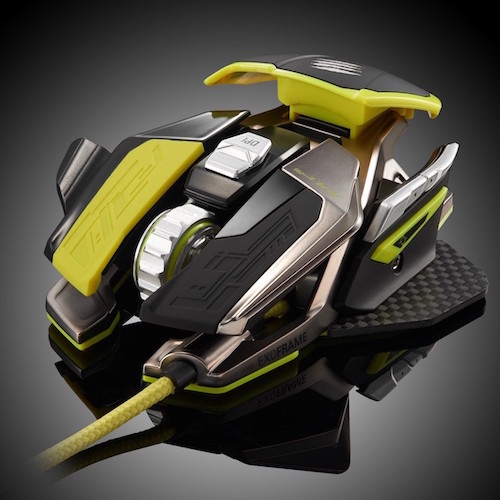
The Mad Catz R.A.T. PRO X (NYSEMKT: MCZ) is Mad Catz Interactive’s latest addition to their mouse line. The features are quite impressive for a mouse: from a magnesium alloy chassis to interchangeable sensor modules, it is one of the most ambitiously different mice on the market.1 This ambition, however, includes some failures of design that should never have crept into a $200 peripheral.

The PRO X is the successor to the R.A.T. 72. The R.A.T. 7 will be used to ascertain the quality of changes made in the PRO X.
Mad Catz’s edgy designs are always surprisingly comfortable. The modular design allows the user to adjust nearly every surface. Most of the mouse is coated with a superhydrophobic substance, which reduces sweat and oil buildup. This feature is unique and puts the PRO X far ahead of most of its competitors.
The mouse itself is one of the fastest mice on the market. It is incredibly light3 and especially smooth to track. The ceramic pads are a feature very few other mice have. If the mouse surface is wood or metal, the lack of friction compared to standard Teflon pads is even more impressive. This mouse is very fast; one will need to reduce the tracking speed.
Adjusting tracking speed can be done through the computer’s preferences or by adjusting the DPI in the companion app. Parting ways from prior releases in the R.A.T. line, the PRO X uses onboard memory to store profiles. The .pro files are also gone4, which is a welcome change.
Interestingly, once the R.A.T. Pro X mouse profiles have been set up on Windows, they also work on OS X even though the support is not declared. The other adjustment all function properly as well. One cannot edit the settings on OS X, however, as the program to modify the mouse firmware is Windows only.5 Regardless, this is a gaming mouse and Apple does not make gaming machines.
True to Mad Catz style, odd angles and modular parts permeate the device. Nearly every aspect of the instrument is customizable to users’ needs. This modular aspect does not come without serious flaws, however.

The aesthetic overall leans towards a hardcore gaming culture. The color choice leaves something to be desired, but the aesthetic ties in well with the rest of the Mad Catz line.
The left and right click buttons are very responsive and yield a satisfying click, as most mice do. The PRO X seems to have far smaller of a depression needed to activate the switches, which lends more credence to the speed of this mouse.
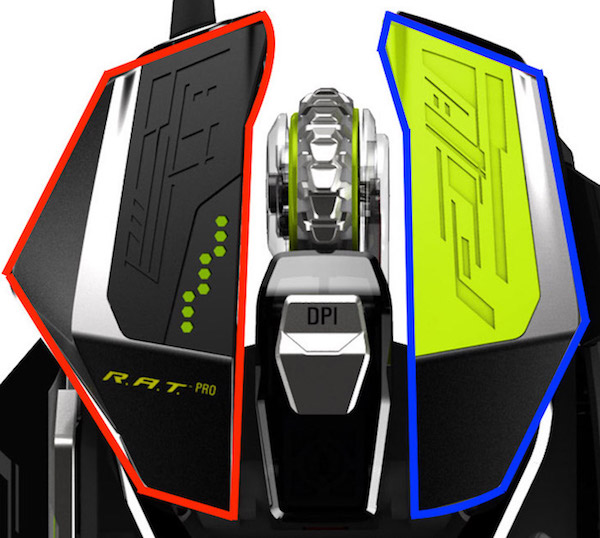
The size of the clickable zone is impressive compared to most mice. The red encompasses the left click zone and the blue contains the right click zone. The zones are deceptively large. These buttons are not easy to inadvertently press, but they are very fast when one needs them to be.
This mouse only has three programmable DPI levels, down from prior models inclusion of four. The button also does not allow stepping up and stepping down like prior models; rather the button acts as a toggle. This behavior means it can take far more button presses to get to the desired DPI level than previous models. The removal of the stepping feature is a silly omission.

The LEDs6 are located to the left of the left mouse button as they were on prior models. However, the LEDs are on the inside of where the user’s finger goes, so one cannot easily see them while using the mouse. This is unlike prior models which had a side-mounted LED indicator:
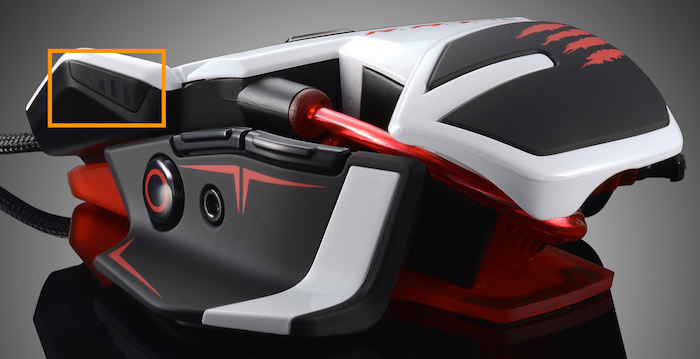
Vertically, the wheel scrolls well. It is highly adjustable regarding ratcheting the wheel, but the fact that this requires a tool is rather silly. Since the tool is no longer mounted inside the mouse7 storing and not losing the tool becomes another chore.
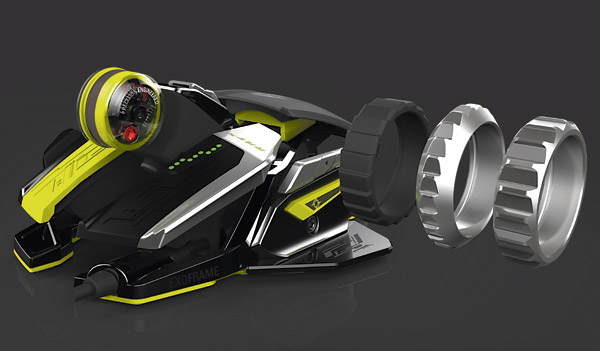
The analog horizontal strafe feature of the scroll wheel is nearly useless. It is a great marketing point but serves almost no purpose in practice. Not only is it difficult to use, but also it is imprecise. Although it allows analog levels of adjustment, the window of actual movement is so small and the strength of the balancing springs so high that it may as well be a toggle. Further, because the mouse wheel is so wide, there is little room to push the wheel in either direction.

The result of this is that the horizontal pitch is so difficult to use one either must shift their grip to move the scroll wheel sideways or simply map the commands to other buttons. Horizontal strafe is an excellent idea, but this is an improper implementation.
The thumb rest on the R.A.T. PRO X is by far the most problematic aspect of the device. On prior devices, the thumb rest was not removable but adjustable horizontally based on a pivot.
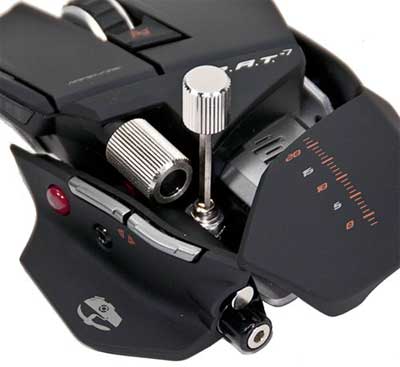
This pivot was great because the contacts that the buttons activated were touching the buttons. Button contacts would not be a thought if the PRO X thumb rest were not so horrendously flawed: in place of allowing the thumb rest to pivot, the PRO X has a removable thumb rest. The removable nature of the part is problematic for several reasons.
First, they require two different sized screws. Should one get lost, it will be impossible to attach that thumb rest anymore. It is just another part to have to store and remember, which is a massive flaw with Mad Catz’s modular designs.
Second, the construction has been done in the worst possible manner. The following image shows the internal design of the inside of the thumb rest:

The silver plastic pegs are attached directly to plastic buttons that stick up above the top of the case. These buttons depress copper contacts inside the body of the mouse:
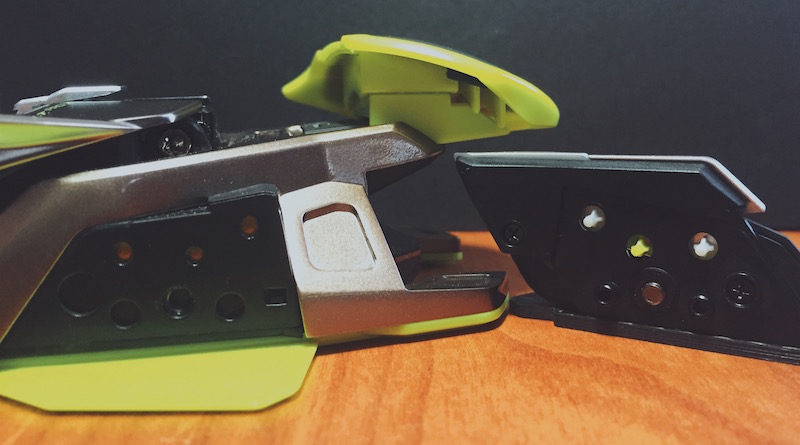
The plastic pegs are not long enough to reach the copper contacts. As such, there is a large space where pressing the button moves the plastic but does not depress the copper contact behind the button. This dead space gives these buttons a very mushy feeling. This type of poor quality construction has no place on a $200 peripheral.
Third, since there is so much button play, the pegs need to use a return mechanism to return to the resting “un-clicked” position. Instead of using springs, they use cheap, thin, flexible plastic that bends every time one presses the buttons:

The poor quality of this design not only gives the button a cheap feeling when being depressed but also prevents them from being returned to a neutral position properly. There should be no issue with buttons clicking on a $200 mouse.
Finally, the above issue with the quality of buttons feels like a manufacturing defect. The pegs are simply too short to make the modular implementation effective. This defect not only detracts from prior releases; it makes the thumb buttons nearly useless. For this reason alone, this mouse is not usable.
The R.A.T. PRO X includes three removable pinkie grips, up from two included with the R.A.T. 7. These are also not without problems.
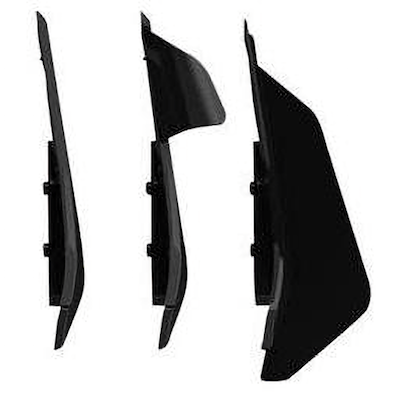
There are two main issues with them. First, the glossy plastic used in the construction of the rests is not coated with a superhydrophobic substance unlike the body of the mouse. Not only does this allow sweat to build up, but also it creates a dichotomy in appearance as none of the body of the mouse uses that material.
More seriously, the pinkie grip designed to aid with liftoff seems to be designed backward. The front edge of the rest has a little “hook” for one’s pinkie. As an idea, this seems awesome, but in practice, this design does not work.

The hook is simply too far forward to grip. Because it is so far forward, it barely touches the tip of one’s pinkie. This disconnect occurs because of the way the palm rest is setup: should one move the palm rest forward to comfortably rest their pinkie under the pinkie grip, the rest of the hand will overshoot the mouse. Proportionally, it is not designed correctly. For such an expensive peripheral, this kind of design defect is unacceptable.
These are the most redeeming quality of the PRO X. They are designed beautifully and are incredibly comfortable. The inclusion of a superhydrophobic coating is something very few other mice have. It makes the mouse extremely comfortable to use while staying grippy at the same time.
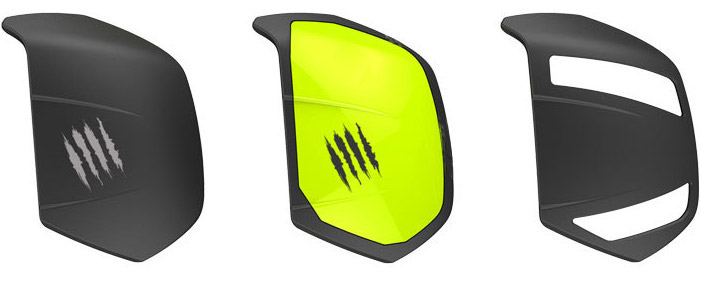
The adjustment works both vertical and horizontally, which adds another way to augment to fit one’s palm. The palm rest with holes allows even more ventilation and shaves off a few more ounces. These are well-designed and robust; they make the mouse very comfortable to use.
| Part | R.A.T. PRO X | R.A.T. 7 |
|---|---|---|
| Weight (no addition) | 105g | 150g |
| Weight (added weights) | N/A | 180g |
| Chassis Construction | Magnesium | Aluminum |
| Thumb Rest Options | 2, Swappable | Horizontal and Vertical Pivot |
| Pinkie Grip Options | 3, Swappable | 2, Swappable |
| Palm Pad Options | 3, Swappable | 3, Swappable |
| Super hydrophobic Coating | Yes | No |
| DPI Adjustment Steps | 3 | 4 |
| DPI Adjustment Button | Cycle | Step |
| DPI LED Orientation | Top | Side |
The PRO X is the most ambitious mouse on the market. The device is nimble, however it is plagued by several pesky problems. The thumb rest is designed so poorly as to be inexcusable. For that reason alone this mouse should not be recommended. Until Mad Catz releases working thumb rests and raises manufacturing standards, the ingenuity and advances put into this mouse are nothing but wasted potential.
Discussion: r/MouseReview
I will not go into specifics regarding the features of the device; you can read their ad copy elsewhere. My focus here is to elucidate problems with the design of the product, not provide an overview. ↩︎
The R.A.T. 9 used a different wireless technology with hot-swappable batteries. It is a slightly modified R.A.T. 7, thus not a successor. ↩︎
Mad Catz claims 105 g. ↩︎
.pro files were used in previous models to store mouse commands. They are still supported for import, but you cannot export them. One does not need to export them either; they are stored in a sidebar within the app. ↩︎
I emailed Mad Catz and inquired about the possibility of OS X software, this was their response:
“In speaking with our development team, it seems that the RAT PRO X was really geared towards the PC market and not the MAC. They do not really have a road map for MAC support for that product as it was never really in the scope of the original build. I reviewed the Amazon copy to make sure that we’re not advertising MAC compatibility, and we’re not. Apologies for any confusion. Seems this may not be the right product for your needs. I appreciate the feedback.”
It is also worth noting that Mad Catz has not updated any of their other software since OS X 10.9 ↩︎
The mouse that I received had one dead LED: the first bottom LED in the row (equated with the lowest DPI level) did not function. ↩︎
Prior releases in the R.A.T. line integrated a removable hex key into the body of the mouse. ↩︎